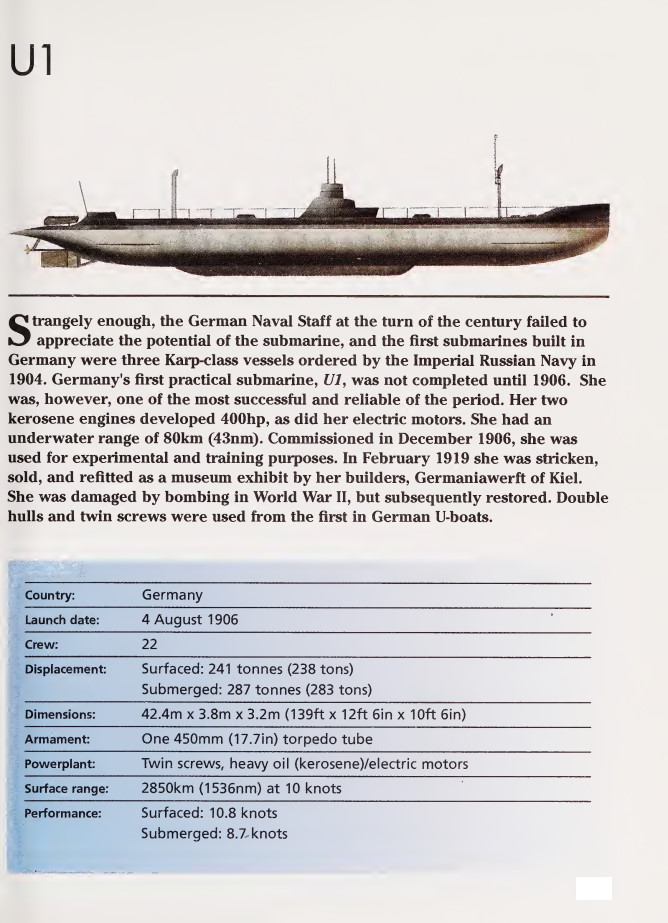
Germany was one of the last of the major powers to begin a submarine-building programme for her navy. In many respects she followed the British model, developing and experimenting with new submarine designs rather than putting them into full production and then discovering that there were operational or constructional problems. While the British intended to use the submarine to defend bases and the coastline, the German navy’s intention was to use them as an offensive arm.
The key battle area would be the North Sea. This meant that any submarine deployed by the Germans would have to have a good operational range, the ability to remain at sea in the challenging winter months and a good surface speed, along with a high level of reliability.
It was not until February 1905 that the German navy awarded the first contract to build a submarine to the Germania Yard at Kiel. U-1 would be a 238-ton vessel with a kerosene engine and a single 45 cm bow torpedo-tube. One of the problems was that the kerosene created clouds of white smoke that could be seen for miles. Nevertheless, U-1 was finished in December 1906, and in the meantime a second and larger submarine had been commissioned to be built at the Imperial Dockyard at Danzig – U-2. In August 1907 two more slightly larger submarines, U-3 and U-4, were also ordered. It transpired that U-1 was unable to meet the operational requirements of the German navy, and the engine was not reliable enough.
The German navy was looking for a vessel that had a 2,000-nautical-mile surface endurance, a speed of 10.5 knots underwater, a surface speed of 15 knots, four torpedo tubes, two bow tubes and the ability to supply a crew of twenty with seventy-two hours’ air supply. Although the next twelve submarines were built with these specifications in mind, they did not fulfil them.
By 1912 it was still considered to be practicable only for the submarines to be out operationally for five days, working no more than 300 nautical miles from their base. In effect this meant they could operate on the eastern side of England and just into the English Channel from Heligoland.
The German’s first submarine casualty took place on 9 August 1914, when U-15 was rammed and sunk by HMS Birmingham. U-13 had been due to return from patrol on 12 August, but she failed to appear, in all probability having struck a German mine.
The German submarines had more success the following month when on the morning of 22 September U-9 sank three British cruisers, HMS Aboukir, HMS Cressy and HMS Hogue. She also managed to sink the cruiser HMS Hawk on 15 October.
Technically, the U-19 Class of German submarine was an enormous step forward. It had a diesel engine, 50 cm torpedo tubes; it was much larger and longer and it also had six torpedo tubes. This type of vessel would provide the blueprint for many of the German submarines up to U-116.
Later on in the war larger submarines were ordered by the German navy, but many of these vessels were never completed. Those that were completed were often named after early German submarine heroes. U-140, for example, was named after Kapitän-leutnant Weddigen, who had commanded U-9 in 1914 but had been killed in action in U-29.
The Germans also deployed mercantile submarines, notably Deutschland (U-155). She was a blockade runner carrying cargo to and from the United States. She made two trips in 1916. Bremen accompanied her on the second trip but never arrived. A third, Oldenburg, was converted into a cruiser U-boat before she was completed. Ultimately Deutschland was also converted, with a pair of bow torpedo tubes and a pair of 15 cm guns.
Later in the war an improved version of this submarine cruiser was proposed, with six torpedo tubes and heavier guns. UD-1 was started but never completed.
When the Germans overran parts of Belgium in 1914 they acquired Bruges and Zeebrugge, both of which would be ideal submarine bases and, of course, closer to the proposed areas of operation. The Germans decided to introduce smaller coastal submarines. These were ordered in November 1914 and came into service at the beginning of 1915. They were known as Type UB submarines, just 88 ft 7 in. long, with a displacement of 127 tons and a pair of torpedo tubes. The idea was that they would be built in sections, transported by rail and then assembled at their base. The first was UB-1, which would operate in the Adriatic. The Type UB-3 came into service during the 1917–18 period. It was much larger: 182 ft long, a displacement of 520 tons and five torpedo tubes. These were such a success that they were to prove to be the blueprint upon which the Germans would design their Type VII U-boats for World War Two.
The Type UB submarines were designed for coastal operations. A smaller, Type UC, of which there were two variants, was also designed as minelayers. These too were transported by rail for final assembly, but the early ones had no means of offence or defence, although later models had torpedo tubes.
The British captured UC-5 and made a careful examination of the wreck of UC-2. This helped them enormously in unravelling German mining strategy and allowed the British to modify their own E Class submarines as minelayers.
There were also smaller Type UE ocean-going minelayers that had torpedo tubes. The later submarines in this series could operate off the United States coastline. A further Type UF coastal submarine was also planned. This was similar to UB-2 but would have four or five 50 cm torpedo tubes, but the Germans did not manage to complete any of these before the end of the war.